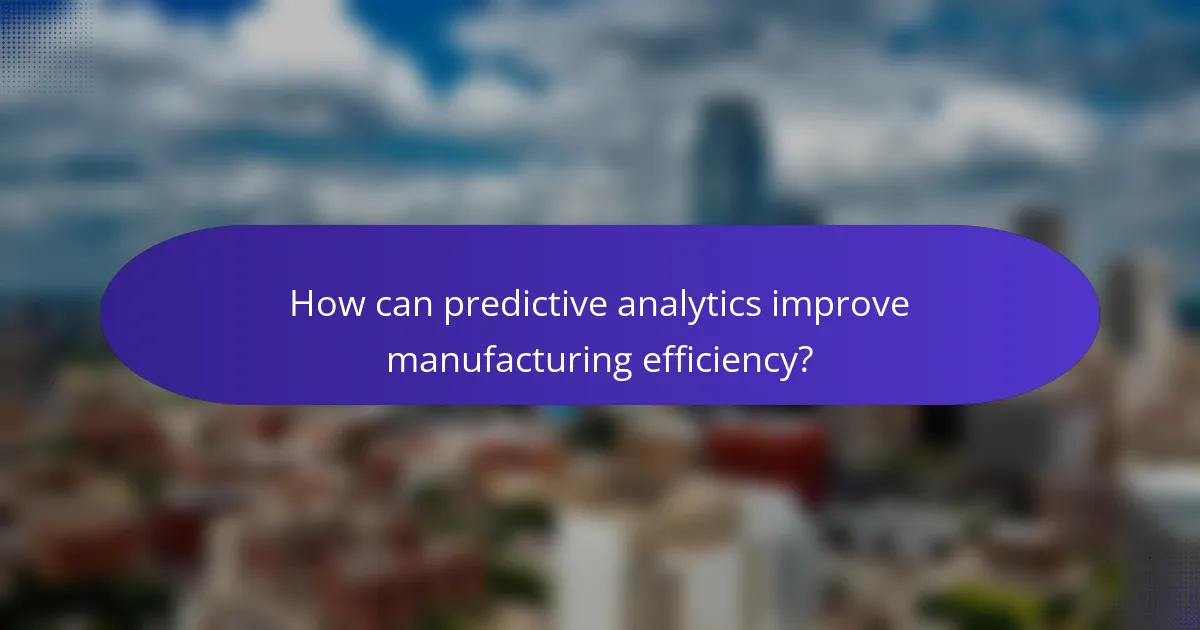Predictive analytics is revolutionizing manufacturing efficiency by utilizing data to foresee challenges, optimize workflows, and enhance overall operations. By employing various forecasting methods such as time series analysis and machine learning, manufacturers can make data-driven decisions that minimize waste and boost productivity. Additionally, the integration of advanced technologies like IoT and AI is shaping the future of manufacturing, enabling real-time data processing and improved decision-making capabilities.

How can predictive analytics improve manufacturing efficiency?
Predictive analytics enhances manufacturing efficiency by leveraging data to anticipate issues, optimize processes, and streamline operations. By analyzing historical data and trends, manufacturers can make informed decisions that reduce waste and improve productivity.
Reduced downtime through predictive maintenance
Predictive maintenance uses data analytics to forecast equipment failures before they occur, significantly reducing downtime. By monitoring machinery in real-time, manufacturers can schedule maintenance during non-peak hours, minimizing disruptions to production.
Implementing predictive maintenance can lead to cost savings by avoiding emergency repairs and extending the lifespan of equipment. For example, manufacturers may see a reduction in unplanned downtime by 20-50% when utilizing these analytics effectively.
Optimized production scheduling
Predictive analytics allows manufacturers to optimize production schedules based on demand forecasts and resource availability. By analyzing patterns in order data, companies can adjust their production plans to align with market needs, reducing excess inventory and improving cash flow.
Using predictive models, manufacturers can achieve more accurate scheduling, which can lead to a decrease in lead times and an increase in on-time delivery rates. This approach ensures that resources are allocated efficiently, enhancing overall operational efficiency.
Enhanced quality control
With predictive analytics, manufacturers can improve quality control by identifying potential defects before they occur. By analyzing data from production processes, companies can detect anomalies and adjust parameters to maintain product quality.
For instance, implementing real-time monitoring systems can help identify trends that lead to defects, allowing for immediate corrective actions. This proactive approach can reduce scrap rates and improve customer satisfaction by ensuring consistent product quality.
Data-driven decision making
Data-driven decision making is a cornerstone of predictive analytics in manufacturing. By relying on data insights rather than intuition, manufacturers can make more accurate and timely decisions that enhance efficiency and profitability.
Establishing a culture that values data can lead to better resource allocation, improved process optimization, and increased competitiveness. Companies should invest in training staff to interpret data effectively and integrate analytics into their daily operations for maximum impact.

What are the key forecasting methods in manufacturing?
The key forecasting methods in manufacturing include time series analysis, regression analysis, and machine learning algorithms. Each method offers unique advantages and can significantly enhance production efficiency and inventory management.
Time series analysis
Time series analysis involves examining historical data points collected over time to identify trends and seasonal patterns. This method is particularly useful for forecasting demand based on past sales data, allowing manufacturers to adjust production schedules accordingly.
When using time series analysis, consider factors such as seasonality and cyclical trends. For example, a manufacturer might notice increased demand for certain products during holiday seasons, which can inform inventory levels months in advance.
Regression analysis
Regression analysis assesses the relationship between a dependent variable and one or more independent variables. In manufacturing, this can help predict outcomes like production costs based on factors such as labor hours or material prices.
To effectively use regression analysis, ensure that the data is clean and relevant. A common pitfall is relying on outdated data, which can lead to inaccurate forecasts. Regularly updating your models with current data can improve accuracy significantly.
Machine learning algorithms
Machine learning algorithms leverage large datasets to identify complex patterns and make predictions. These algorithms can adapt over time, improving their accuracy as more data becomes available, making them suitable for dynamic manufacturing environments.
Implementing machine learning requires a solid understanding of data science principles and access to quality data. Manufacturers should start with a clear objective, such as reducing waste or optimizing supply chains, and gradually build their models to refine predictions.

What trends are shaping predictive analytics in manufacturing?
Predictive analytics in manufacturing is increasingly influenced by advancements in technology and data management practices. Key trends include the integration of IoT devices, the adoption of AI technologies, and a shift towards real-time data processing, all of which enhance operational efficiency and decision-making.
Integration of IoT devices
The integration of Internet of Things (IoT) devices is revolutionizing predictive analytics in manufacturing by providing real-time data from machinery and equipment. These devices collect vast amounts of data on performance, maintenance needs, and operational conditions, allowing manufacturers to make informed predictions about equipment failures and production bottlenecks.
For example, a factory might use IoT sensors to monitor machine temperatures and vibrations, enabling predictive maintenance that can reduce downtime by up to 30%. Manufacturers should ensure that their IoT systems are secure and that data is analyzed promptly to maximize the benefits.
Adoption of AI technologies
Artificial Intelligence (AI) technologies are playing a crucial role in enhancing predictive analytics capabilities. AI algorithms can analyze complex datasets to identify patterns and trends that human analysts might miss, leading to more accurate forecasts and insights.
Manufacturers are increasingly using machine learning models to predict demand fluctuations and optimize inventory levels. Implementing AI solutions requires a clear strategy, including selecting the right tools and ensuring staff are trained to interpret AI-generated insights effectively.
Shift towards real-time data processing
The shift towards real-time data processing is essential for effective predictive analytics in manufacturing. By processing data as it is generated, manufacturers can respond quickly to changes in production conditions and market demands, improving overall efficiency.
For instance, real-time analytics can help a manufacturer adjust production schedules based on immediate sales data, reducing excess inventory and minimizing waste. Companies should invest in robust data infrastructure and analytics platforms to support this shift and ensure they can handle large volumes of data efficiently.

What are the prerequisites for implementing predictive analytics?
To successfully implement predictive analytics, organizations must ensure they have the right data quality, a skilled workforce, and adequate technology infrastructure. These elements are crucial for generating accurate forecasts and improving manufacturing efficiency.
Data quality and availability
High-quality data is essential for effective predictive analytics. Organizations should focus on collecting accurate, relevant, and timely data from various sources, such as production logs, sensor readings, and supply chain records. Data should be cleaned and standardized to eliminate inconsistencies that could skew analysis.
Availability of data is equally important. Companies must ensure that data is accessible across departments and systems. This often involves integrating data from different sources and ensuring that it is stored in a centralized location for easy retrieval and analysis.
Skilled workforce
A skilled workforce is vital for leveraging predictive analytics effectively. Employees should possess expertise in data science, statistics, and domain knowledge specific to manufacturing processes. Training existing staff or hiring new talent with these skills can significantly enhance the organization’s analytical capabilities.
Collaboration between data scientists and manufacturing professionals is crucial. This teamwork ensures that insights derived from data analytics are relevant and actionable, leading to improved decision-making and operational efficiency.
Investment in technology infrastructure
Investing in the right technology infrastructure is necessary for implementing predictive analytics. This includes robust data storage solutions, advanced analytics software, and machine learning tools that can handle large datasets efficiently. Organizations should evaluate their current systems and identify gaps that need to be addressed.
Additionally, maintaining up-to-date technology is important to keep pace with evolving analytical techniques. Regularly upgrading software and hardware can help organizations stay competitive and make the most of their predictive analytics initiatives.

How to choose the right predictive analytics tools for manufacturing?
Choosing the right predictive analytics tools for manufacturing involves assessing your specific needs, scalability, and integration capabilities. Prioritize solutions that can grow with your operations and seamlessly connect with existing systems to maximize efficiency.
Scalability of the solution
Scalability is crucial when selecting predictive analytics tools, as manufacturing needs can change rapidly. Look for solutions that can handle increasing data volumes and user demands without significant performance degradation.
Consider tools that offer flexible pricing models, allowing you to start small and expand as your business grows. This approach helps manage costs while ensuring that the analytics capabilities can evolve alongside your operations.
Compatibility with existing systems
Compatibility with existing systems is vital for a smooth implementation of predictive analytics tools. Ensure that the chosen solution can integrate with your current software, such as ERP or MES systems, to facilitate data sharing and analysis.
Evaluate the ease of integration by checking for available APIs or pre-built connectors. This can significantly reduce the time and resources needed for deployment, minimizing disruptions to your manufacturing processes.


